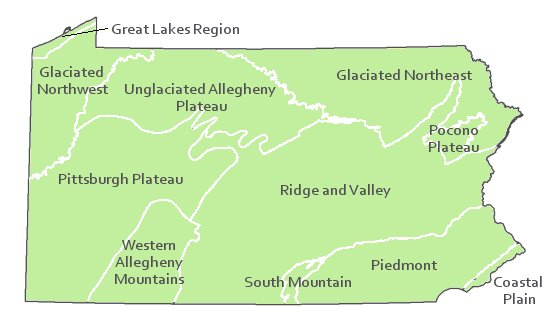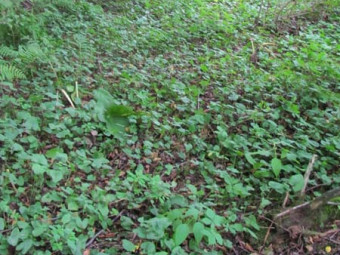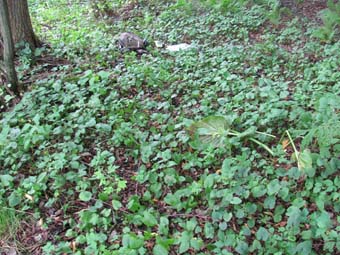Skunk-cabbage – Golden Saxifrage Seep
System: Palustrine
Subsystem: Herbaceous
PA Ecological Group(s): Seepage Wetland
Global Rank:GNR
![]() rank interpretation
rank interpretation
State Rank: S4S5
General Description
A seep is where groundwater flow meets the surface and diffuses through soil before emerging over a significant area (as opposed to a spring, where groundwater emerges as a concentrated flow). The constant flow of groundwater keeps the soil saturated. The water is always clear and cool, and may have mineral enrichment, because it comes from groundwater sources. This unique habitat hosts several plant and animal species that cannot utilize other wetlands where water levels fluctuate seasonally. Where groundwater flow is sufficient to form a channel of water, it is called a spring. Pennsylvania has many seeps because of the predominance of sedimentary rock formations; water infiltrates from the surface, flows downwards until it hits an impervious layer of rock, then follows this layer until it surfaces, forming a seep.
This type includes small herbaceous seepage areas with scattered to moderately dense cover of broadleaf and grass-like plants. Typically the community is over-topped by trees and shrubs from the surrounding forest, although large examples will be open. Herbaceous species are strongly dominant and tend to be relatively diverse, especially where there is greater mineral enrichment.
Species composition is highly variable, but can include turtlehead (Chelone glabra), red maple (Acer rubrum), Jack-in-the-pulpit (Arisaema triphyllum) Pennsylvania bittercress (Cardamine pensylvanica), sedge (Carex prasina), winterberry (Ilex verticillata), spicebush (Lindera benzoin), hornbeam (Carpinus caroliniana), skunk-cabbage (Symplocarpus foetidus), golden saxifrage (Chrysosplenium americanum), cinnamon fern (Osmunda cinnamomea), sedge (Carex scabrata), jewelweed (Impatiens capensis), spinulose wood fern (Dryopteris carthusiana), Pennsylvania bittercress (Cardamine pensylvanica), clearweed (Pilea pumila), , slender mannagrass (Glyceria melicaria), swamp saxifrage (Saxifraga pensylvanica), and sensitive fern (Onoclea sensibilis). Bryophytes include Brachythecium rivulare, Bryhnia novae-angliae, Rhynchostegium serrulatum, Rhizomnium punctatum, Sphagnum spp., and Thuidium delicatulum. Shrubs may be present, common representatives include alders (Alnus spp.), spicebush (Lindera benzoin), viburnums (Viburnum spp.), and dogwoods (Cornus spp.).
The pH of these forested seep communities varies widely and this significantly influences species composition. Seeps with moderately to strongly calcareous groundwater ([Ca] >15mg/l) often contain one to several calciphilic species in addition to the speices listed above.
Rank Justification
Uncommon but not rare; some cause for long-term concern due to declines or other factors.
Identification
- Seeps are best identified by groundwater discharge all or most of the year (some seeps may go dry by late summer)
- They often occur at the base of slopes, although they may also occupy a mid-slope position.
- Golden saxifrage, Carex scabrata, Carex prasina, and Carex trisperma are good indicators of seepage, as these species rarely occur in areas that have seasonally fluctuating water levels.
- The Skunk-cabbage – Golden Saxifrage Forest Seep occurs within a forested landscape, typically with skunk-cabbage and/or golden saxifrage as dominants, and it has a moderately acidic to calcareous pH.
- The calcareous subtype will have high pH (6.5 or greater) and will have some calcium-loving plant species present.
Trees
Herbs
- Skunk cabbage (Symplocarpus foetidus)
- Golden saxifrage (Chrysosplenium americanum)
- Sedge (Carex folliculata)
- Sedge (Carex prasina)
- Jewelweed (Impatiens capensis)
- Spinulose wood fern (Dryopteris carthusiana)
- Pennsylvania bittercress (Cardamine pensylvanica)
- Clearweed (Pilea pumila)
- Slender mannagrass (Glyceria melicaria)
- Swamp saxifrage (Saxifraga pensylvanica)
- Sensitive fern (Onoclea sensibilis)
- Turtlehead (Chelone glabra)
- Jack-in-the-pulpit (Arisaema triphyllum)
Bryophytes
* limited to sites with higher soil calcium
Vascular plant nomenclature follows Rhoads and Block (2007). Bryophyte nomenclature follows Crum and Anderson (1981).
International Vegetation Classification Associations:
USNVC Crosswalk:None
Representative Community Types:
Skunk-cabbage - Orange Jewelweed Seep (CEGL006567)
NatureServe Ecological Systems:
Central and Southern Appalachian Spruce-Fir Forest (CES202.028)
High Allegheny Wetland (CES202.069)
Appalachian (Hemlock)-Northern Hardwood Forest (CES202.593)
NatureServe Group Level:
None
Origin of Concept
Fike, J. 1999. Terrestrial and palustrine plant communities of Pennsylvania. Pennsylvania Natural Diversity Inventory. Pennsylvania Department of Conservation and Recreation, Bureau of Forestry, Harrisburg, PA. 86 pp.
Pennsylvania Community Code*
HK : Skunk Cabbage – Golden Saxifrage Forest Seep
*(DCNR 1999, Stone 2006)
Similar Ecological Communities
The Golden Saxifrage – Sedge Rich Seep receives more light than does this type. The greater light availability is reflected in the species composition. The Golden Saxifrage – Pennsylvania Bitter-cress Spring Run Community is also groundwater fed, but in the case of a spring, water comes to the surface in a concentrated rather than diffuse flow.
Fike Crosswalk
Skunk cabbage - golden saxifrage forest seep
Conservation Value
Seepage wetlands are unique because they provide a constant source of water at a relatively even flow and temperature throughout the growing season. They are utilized by amphibians and aquatic insects for breeding. Some plant species are also specifically adapted for seepage wetlands. This community type is currently broadly defined and includes forested seeps with a range of pH values. In examples of this community type receiving calcium enriched groundwater, several plants of special concern in Pennsylvania can be found: rough-leaved aster (Eurybia radula), spreading globe-flower (Trollius laxus), hemlock-parsley (Conioselinum chinense), and grass-of-Parnassus (Parnassia glauca).
Threats
The greatest threat to these communities is bedrock disruptions such as drilling or mining in nearby areas, which can contaminate or alter the flow patterns of the groundwater that feeds the seepage. Groundwater pollution can also occur from improperly installed septic systems, from improperly lined underground waste disposal, and in agricultural areas from infiltration of pesticides, fertilizer applications on lawns and agricultural fields, and bacteria from animal wastes. Removal of natural vegetation cover adjacent to the wetland can affect water levels and temperatures by increasing solar heating and evaporation. Invasive plant species can threaten the biological integrity of the community. The terrain and vegetation within this community are sensitive to foot traffic.
Management
Drilling, mining, or other disruptions to bedrock should not be undertaken within a half mile of a seepage wetland without a thorough understanding of bedrock layers and groundwater flows. Groundwater flow patterns do not always mirror surface watersheds, and in some cases aquifers may be contiguous over large areas. Seepage wetlands are also sensitive to trampling and other physical disturbance from recreational activities; trails should be sited away from the wetland, or elevated structures employed to prevent traffic in the wetland.
Research Needs
Fike (1999) described a "calcareous subtype," of the Skunk Cabbage - Golden Saxifrage Seep, which differentiated from the what is described here by the influence of moderately to strongly calcareous groundwater ([Ca] >15mg/l). Fike's stated that the subtype included the species in the more general concept, but usually with the additional presence of one to several calciphilic species. The species of calciphile present varies; typical representatives include spreading globeflower (Trollius laxus), hemlock parsley (Conioselinum chinense), and grass-of-Parnassus (Parnassia glauca). These species also have higher light requirements, so sites or portions of sites on which they occur tend to be somewhat open. Becuase of this, there is a high degree of overlap with the Golden Saxifrage - Sedge Rich Seep and more work needs to be done to determine if this calcareous subtype should be recognized.
Calcareous and circumneutral seepage wetlands in Pennsylvania have been studied and classified, but acidic seepage wetlands have not. These may have different floristic composition and merit further study. Different types may have different conservation needs; for example, the calcareous subtype is certainly less prevalent in Pennsylvania than acidic seepage wetlands.
Trends
Specific figures for this wetland community type are not available.
Range Map

Pennsylvania Range
Statewide
Global Distribution
Connecticut, Delaware, Massachusetts, Maryland, New Hampshire, New York, Rhode Island, Virginia, Vermount, and West Virginia.
Byers, E. A., J. P. Vanderhorst, and B. P. Streets. 2007. Classification and conservation assessment of high elevation wetland communities in the Allegheny Mountains of West Virginia. West Virginia Natural Heritage Program, West Virginia Division of Natural Resources, Elkins.
Dahl, T.E. 1990. Wetlands losses in the United States 1780's to 1980's. U.S. Department of the Interior, Fish and Wildlife Service. Washington, D.C. http://www.npwrc.usgs.gov/resource/othrdata/wetloss/wetloss.htm (Version 16JUL97).
Dahl, T.E. 2006. Status and trends of wetlands in the conterminous United States 1998 to 2004. U.S. Department of the Interior; Fish and Wildlife Service, Washington, D.C. 112 pp.
Eastern Ecology Working Group of NatureServe. No date. International Ecological Classification Standard: International Vegetation Classification. Terrestrial Vegetation. NatureServe, Boston, MA.
Fike, J. 1999. Terrestrial and palustrine plant communities of Pennsylvania. Pennsylvania Natural Diversity Inventory. 86 p.
Khan, Nancy R., Ann F. Rhoads, and Timothy A. Block. 2005. Characterization and assessmant of the Floristic Resources in Evansburg State Park. Report submitted to DCNR, Bureau of State Parks.
Khan, Nancy R., Ann F. Rhoads, and Timothy A. Block. 2008. Vascular flora and community assemblages of Evansburg State Park, Montgomery County, Pennsylvania. Bulletin of the Torrey Botanical Club 135(3): 438-458.
NatureServe 2010. NatureServe Explorer: An online encyclopedia of life Version 7.1. NatureServe, Arlington, VA. Available http://www.natureserv.org/explorer (accessed: 23 November 2011).
Pennsylvania Department of Conservation and Natural Resources (DCNR). 1999. Inventory Manual of Procedure. For the Fourth State Forest Management Plan. Pennsylvania Bureau of Forestry, Division of Forest Advisory Service. Harrisburg, PA. 51 ppg.
Rhoads, Ann F. and Timothy A. Block. 2004. East Goshen Township Wetlands; Vegetation Inventory and Management Recommendations. Reoprt submitted to East Goshen Township, Chester County, PA.
Rhoads, Ann F. and Timothy A. Block. 2005. Jacobsburg Environmental Education Center Vegetation Inventory. Report submitted to DCNR, Bureau of State Parks.
Rhoads, Ann F. and Timothy A. Block. 2005. Lackawanna State Park Vegetation Inventory. Report Submitted to DCNR, Bureau of State Parks.
Rhoads, Ann F. and Timothy A. Block. 2008. Natural Resources Inventory of French Creek State Park. Report submitted to DCNR, Bureau of State Parks.
Stone, B., D. Gustafson, and B. Jones. 2006 (revised). Manual of Procedure for State Game Land Cover Typing. Commonwealth of Pennsylvania Game Commission, Bureau of Wildlife Habitat Management, Forest Inventory and Analysis Section, Forestry Division. Harrisburg, PA. 79 ppg.
Cite as:
Mcpherson, J. 2022. Pennsylvania Natural Heritage Program. Skunk-cabbage – Golden Saxifrage Seep Factsheet. Available from: https://naturalheritage.state.pa.us/Community.aspx?=16013 Date Accessed: April 19, 2024








